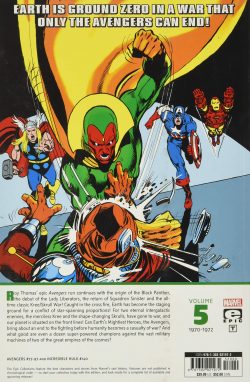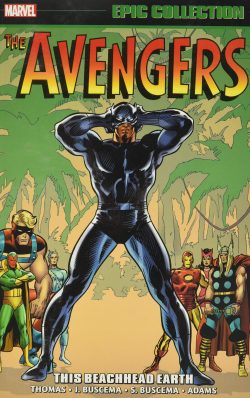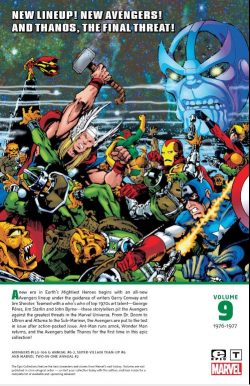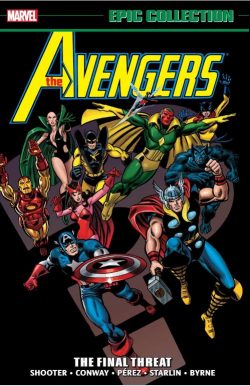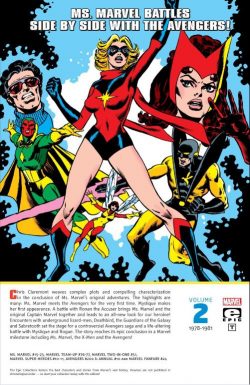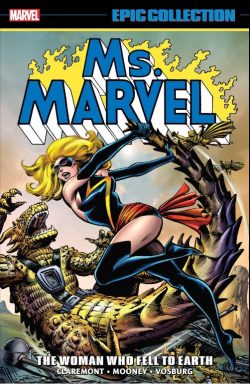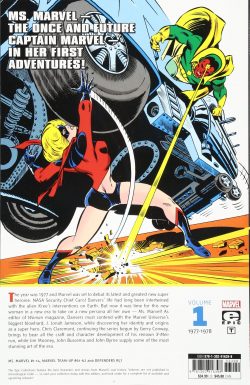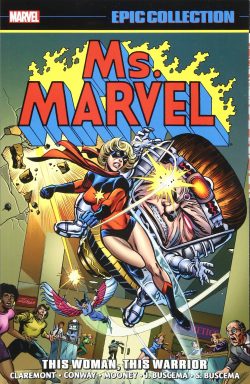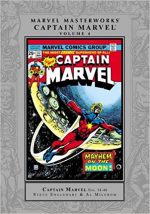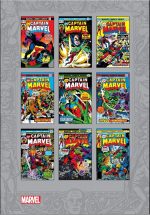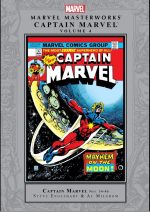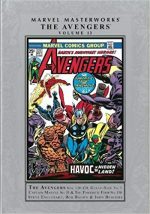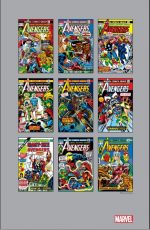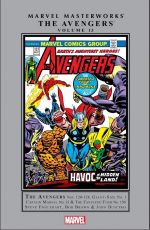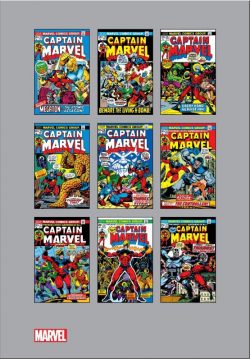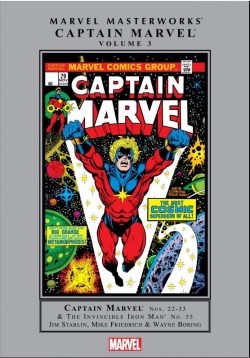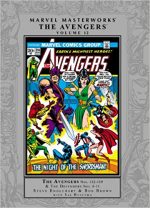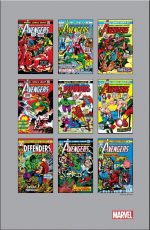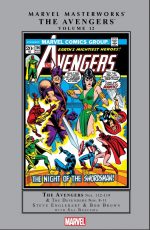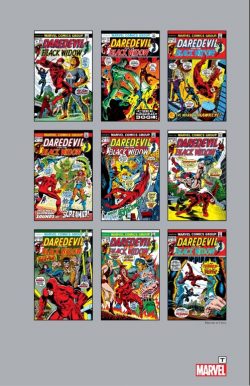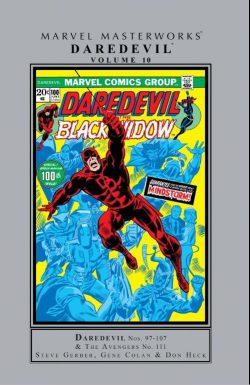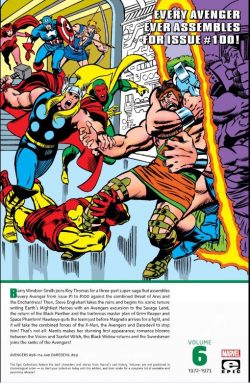
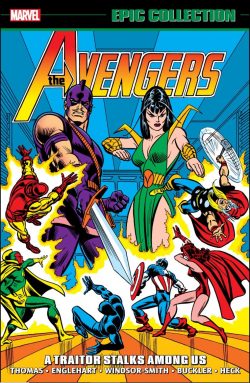
By Roy Thomas, Harlan Ellison, Steve Englehart, Steve Gerber, Chris Claremont, Barry Windsor-Smith, Rick Buckler, John Buscema, Don Heck, George Tuska, Jim Starlin, Bob Brown, Sam Kweskin & various (Marvel)
ISBN: 978-1-3029-2911-4 (TPB)
One of the most momentous events in comics (and now, film) history came in the middle of 1963 when a disparate gang of heroic individuals banded together to combat an apparently out of control Incredible Hulk.
The Avengers combined most of the company’s fledgling superhero line in one bright, shiny and highly commercial package. Over the intervening decades the roster has unceasingly changed, and now almost every character in the Marvel multiverse has at some time numbered amongst their colourful ranks…
After instigators Stan Lee & Jack Kirby moved on, the team prospered under the guidance of Roy Thomas who grew into one of the industry’s most impressive writers, guiding the World’s Mightiest Heroes through a range of adventures ranging from sublimely poetic to staggeringly epic. He then handed over the scripting to a young writer who carried the team to even greater heights…
This stunning trade paperback compilation – also available in eBook iterations – assembles Avengers #98-114, plus a crucial crossover episode from Daredevil #99: collectively covering April 1972 to August 1973, confirming an era of cosmic catastrophe and cataclysmically captivating creative cross-pollination…
Even after saving the world, life goes on and seemingly gets more dangerous every day. Having ended war between the star-spanning Kree and Skrulls, ‘Let Slip the Dogs of War’ (#98, by Thomas, Barry Windsor-Smith & Sal Buscema) sees harried heroes Captain America, Iron Man, the Vision, Quicksilver, Scarlet Witch and Thor debating the loss of their comrade Goliath, missing in action since he explosively stopped a Skull warship from nuking Earth…
As the Thunderer heads for Asgard and its magic scrying mirrors, the fruitless debate is curtailed as war-mongering demagogue Mr. Tallon incites riot in the streets of New York. The gathered crowds attack the Avengers when they tried to quell the unrest and it is soon evident that the war-hawk has supernatural assistance.
…And in the dimensional void the Thunder God discovers all access to the Immortal Realms has been cut off…
By the time he returns to Earth his comrades are bewitched too. Joining with the seemingly immune Vision in a last-ditch, hopeless battle, the Storm Lord fights his greatest allies until the tide is turned by a perfectly-aimed arrow, heralding the return of Goliath to his original identity… Hawkeye.
Moreover, he has with him another Avenger: an amnesiac Hercules, Prince of Power, whose only certain knowledge is that Earth and Asgard are jointly doomed…
Inked by Tom Sutton, ‘…They First Make Mad!’ expands the epic as the Avengers call on all their resources to cure Hercules and decipher his cryptic warning whilst Earth’s leaders seem determined to catapult the planet into atomic Armageddon.
As Hawkeye explains his miraculous escape from death in space and how he found Hercules, the desperate call to assemble goes out, summoning every hero who has ever been an Avenger. Suddenly, two Grecian Titans materialise to trounce the team, dragging the terrified Prince of Power back to Olympus…
The saga ends in the staggeringly beautiful anniversary 100th issue ‘Whatever Gods There Be!’ (inked by Smith, Joe Sinnott & Syd Shores) as thirteen Avengers – including even the scurrilous Swordsman and blockbusting Hulk – invade the home of the Hellenic Gods to discover old enemy Enchantress and war god Ares are behind the entire malignant plot…
It’s always tricky starting fresh after an epic conclusion but Thomas and debuting penciller Rich Buckler – doing his best Neal Adams impersonation – had a secret weapon in mind: a Harlan Ellison tale inked by veteran brushman Dan Adkins.
‘Five Dooms to Save Tomorrow!’ was based on the novella from 1964 and sees the Avengers battling Leonard Tippit, an ordinary man granted god-like power so that he could murder five innocent human beings. To be fair though, those innocuous targets’ continued existence threatened Earth’s entire future…
Determined to stop him whatever the ultimate consequences, the Avengers eschew murky moral quandaries and are tested to their utmost, before the crisis is averted…
They are on firmer, more familiar ground in #102 when the Grim Reaper returns, offering to place the Vision’s consciousness in a human body in return for the android’s allegiance in ‘What to Do till the Sentinels Come!’ (Thomas, Buckler & Joe Sinnott). Meanwhile, the mutant-hunting robots kidnap the Scarlet Witch and start another scheme to eradicate the threat of Homo Superior forever…
A budding romance between the Witch and the Vision exposes tensions and bigotries in most unexpected places as the cataclysmic tale continues with ‘The Sentinels are Alive and Well!’ as the team search the globe for the monstrous mechanical marauders before being captured themselves whilst invading their Australian Outback hive.
The tale concludes ‘With a Bang… and a Whimper!’ as the assemblers thwart a project to sterilise humanity – but only at the cost of two heroes’ lives…
The grieving Scarlet Witch takes centre stage in #105 as ‘In the Beginning was… the World Within!’ pairs neophyte scripter Steve Englehart with veteran artists John Buscema & Jim Mooney. The team travel to South America and encounter cavemen mutants from the antediluvian Savage Land, after which the Avengers discover ‘A Traitor Stalks Among Us!’ (art by Buckler, George Tuska & Dave Cockrum) with the revelation that perennial sidekick Rick Jones has become atomically bonded to alien hero Captain Marvel: a revelation that triggers a painful flashback in memory-blocked Captain America, just as an old foe turns the team against itself.
Limned by Jim Starlin, Tuska & Cockrum, Avengers #107 reveals ‘The Master Plan of the Space Phantom!’ and his complex and sinister alliance with the Grim Reaper even as the love-sick Vision finally accepts the Faustian offer of a human body.
Unfortunately, the corpus on offer is the Star-Spangled Avenger’s…
‘Check… and Mate!’ – illustrated by veteran Avenger artist Don Heck and inkers Cockrum & Sinnott – wraps up the intriguing saga in spectacular fashion as an army of Avengers thrash Phantom, Reaper and assorted hordes of Hydra hoods. However, the true climax is the Vision and Witch’s final acknowledgement of their love for each other.
The announcement provokes a storm of trouble…
In #109 Hawkeye – who’s always carried a torch for Wanda – quits the team in a dudgeon and ‘The Measure of a Man!’ (Heck & Frank McLaughlin) finds the heartsick archer duped by billionaire businessman Champion and nearly responsible for causing the complete destruction of California before wising up to save the day…
Next the depleted team of Captain America, Thor, Iron Man, Scarlet Witch, Vision and Black Panther investigate the disappearance of mutant heroes the X-Men and are thoroughly beaten by an old enemy with a new power.
‘… And Now Magneto!’ (Englehart, Heck, Frank Giacoia & Mike Esposito) ends with half the team brainwashed captives of the villain with the remaining crusaders desperately seeking new allies. We then pop over to San Francisco and a crossover from Daredevil and the Black Widow #99 (May 1973, by Steve Gerber, Sam Kweskin & Syd Shores).
‘The Mark of Hawkeye!’ sees Natasha Romanoff‘s old boyfriend fetch up on the Widow’s doorstep, determined to “reclaim†her. The caveman stunt culminates in the Archer’s sound and well-deserved thrashing, and when the last Avengers arrive, asking him to return and assist, he refuses. DD and the Widow don’t, though…
The saga resumes and concludes in Avengers #111 as, ‘With Two Beside Them!’ (Englehart, Heck & Esposito) the returned heroes and West Coast vigilantes successfully rescue X-Men and Avengers enslaved by malevolent Magneto. With the action over, Daredevil returns to California, but the Black Widow elects to stay with the World’s Mightiest Heroes…
Escalating cosmic themes and colossal clashes commence here with Avengers #112 and ‘The Lion God Lives!’ (Don Heck & Frank Bolle art) wherein a rival African deity manifests to destroy the human avatar of the Panther God. As T’Challa and his valiant comrades tackle that threat, in the wings an erstwhile ally/enemy and his exotic paramour make their own plans for the team…
Unreasoning prejudice informs #113’s ‘Your Young Men Shall Slay Visions!’ (art by Bob Brown & Bolle) wherein a horde of fundamentalist bigots – offended by the “unnatural†love between Wanda, the mutant and artificial being the Vision – turn themselves into human bombs to destroy the sinful, unholy couple. Soon after, ‘Night of the Swordsman’ (Brown & Esposito) formally introduces the reformed swashbuckler and his enigmatic psychic martial artist paramour Mantis to the team… just in time to thwart the Lion God’s latest scheme…
Rewarded with probationary status and the benefit of the doubt, they are in place for a forthcoming clash that will rock the universes…
As if extra enticements are even necessary, also included in this compendium are the stunning front and back covers crafted by Stuart Immonen, Wade von Grawbadger & Marie Javins for Essential Avengers #1-3, and original art covers, pages and unused pencils by Windsor, Smith, Buckler, John Buscema, Starlin, Heck, Cockrum and Brown.
Roy Thomas and Steve Englehart were at the forefront of Marvel’s second generation of story-makers; brilliantly building on and consolidating the compelling creations of Stan Lee, Jack Kirby & Steve Ditko while spearheading and constructing a logical, fully functioning wonder-machine of places and events that so many others were inspired by and could add to.
These terrific tales are ideal examples of superheroes done exactly right: pivotal points as the underdog company evolved into a corporate entertainment colossus. These are some of the best superhero stories you’ll ever read and Englehart’s forthcoming concoctions would turn the Marvel Universe on its head and pave the way for a new peak of cosmic adventure…
© 2021 MARVEL.

